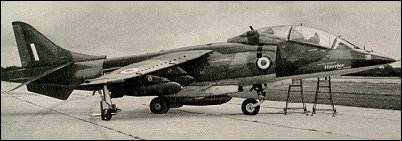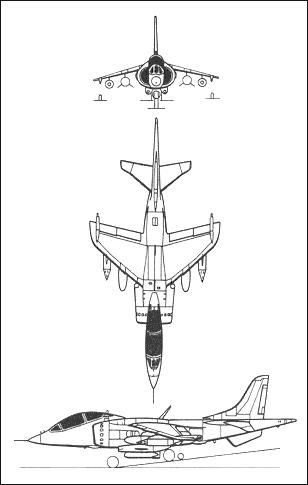|
| The Harrier family was started with the Hawker P.1127. Design began in 1957 by Sir Sidney Camm, Ralph Hooper of Hawker Aviation and Stanley Hooker of the Bristol Engine Company. Rather than using rotors or a direct jet thrust the P.1127 had an innovative vectored thrust turbofan engine and the first vertical take-off was on October 21, 1960. Six prototypes were built in total, one of which was lost at an air display.
Hawker Siddeley Kestrel
The P.1127 was renamed Kestrel after Hawker Siddeley Aviation was created. The Kestrel was an evaluation aircraft, and nine were produced, the first flying on March 7, 1964. The Kestrel had fully swept wings and a larger tail than the P.1127, and the fuselage was modified to take the larger 15,000 lbf (85 kN) Pegasus engine. Due to interest from the US and Germany the Tri-partite Evaluation Squadron was formed, staffed by military test pilots from Britain, the US and West Germany. After testing at RAF West Raynham, the eight surviving evaluation aircraft were transferred to the USA for evaluation by the Army, Air Force and Navy (including USMC) as the XV-6A. After Tri-Service evaluation they were passed to the USAF for further evaluation at Edwards AFB.
An order for 60 aircraft was received from the RAF in 1966, and the first pre-production Harriers were flying by mid-1967.
Harrier GR.1
The Harrier GR Mk.1 was the first production model taken from the Kestrel, it first flew on December 28, 1967, and entered service with the RAF on April 1, 1969. Construction took place at factories in Kingston-upon-Thames in southwest London and at Dunsfold, Surrey. The latter adjoined an airfield used for flight testing; both factories have since closed. The ski-jump technique for STOL use by Harriers launched from Royal Navy aircraft carriers was tested at the Royal Navy's airfield at Yeovilton, Somerset. Their flight decks were designed with an upward curve to the bow following the successful conclusion of those tests. The air combat technique of vectoring in forward flight, or viffing, was evolved in the Harrier to outmaneuver a hostile aircraft or other inbound weapon.
Harrier GR.1A
The GR.Mk 1A was an upgraded version of the GR.Mk 1, the main difference being the uprated Pegasus Mk 102. 58 GR.Mk 1As entered RAF service, 17 GR.Mk 1As were produced and a further 41 GR.Mk 1s were upgraded.
Harrier GR.Mk 3
The Harrier GR.3 featured improved sensors, countermeasures and a further uprated Pegasus Mk 103 and was to be the ultimate development of the 1st generation Harrier. They bravely fought in the Falklands War.

| CREW | 1 |
| ENGINE | 1 x RR/Brist. "Pegasus 6", 85.4kN |
| WEIGHTS |
| Take-off weight | 7260 kg | 16006 lb |
| Empty weight | 5440 kg | 11993 lb |
| DIMENSIONS |
| Wingspan | 7.7 m | 25 ft 3 in |
| Length | 14.2 m | 47 ft 7 in |
| Wing area | 18.7 m2 | 201.28 sq ft |
| PERFORMANCE |
| Max. speed | M1.25 | M1.25 |
| Ceiling | 15600 m | 51200 ft |
| Range w/max.fuel | 3700 km | 2299 miles |
| Range w/max payload | 1000 km | 621 miles |
| ARMAMENT | 2 x 30mm cannons, 2270kg of weapons |
| TJ Cuny, e-mail, 11.05.2016 20:31 Flew the AV-8 for 15 years with the US Marines and Italian Navy! Most exciting aircraft in the world!! reply | | TORBJÍRN KAMPE, e-mail, 26.05.2015 16:40 viggen can back on the ground. but a harrier it can back into the air.
Harrier makes things like f-35b can not do. guess what?. reply | | George Haloulakos, CFA, e-mail, 25.06.2014 21:09 The Harrier exemplifies the RAF motto of "Agile - Adaptable - Capable." The Harriers accounted for 28% of Argentinian combat air losses while losing none in air-to-air combat during the Falkland Islands War. All of this, and more, is covered in chapter 5 of my new book. Here is the info.:
HIGH FLIGHT
Aviation as a Teaching Tool for Finance,
Strategy and American Exceptionalism
By George A. Haloulakos, MBA, CFA
ISBN: 9780-1007-2738-0
Order your copy online at: ucsandiegobookstore.com
Or by phone: 858-534-4557
"Partial proceeds support aviation heritage" reply | | Klaatu83, e-mail, 27.07.2012 16:24 The U.S. Marines used Harriers, but the U.S. Navy rejected them. Why the U.S. Navy should have done that is still baffling. The only reason I can uncover was a prejudice against the operation of single-engine carrier-based aircraft, which makes as little sense as the prejudice the British once had against monoplanes.
I have since read that the U.S. Navy is planning to reject the new F-35 VTOL fighter because it lacks an effective tail hook. What does a VTOL aircraft need with a tail hook? Madness! reply | |
| | Capt. Robert Thomas, e-mail, 30.08.2011 22:48 Sea Harrier coupled with the USN concept Sea Control Ship c.1970 could have made all navies (and aircraft carries) obsolete. At one fifth the cost of a CVA, a vast fleet was possible and freedom of the seas assured. reply | | sjkahhajksfd, e-mail, 02.06.2011 21:34 hey reply | | David Horton, e-mail, 28.02.2011 18:33 Anyone know the whereabouts of Robin Kent? - old bucaneer pilot - flew AV-8A's with the US Marines then back to the Sea Harrier. He was my squadron mate in VMA-231 - reply | | Andreas F., 09.02.2011 22:26 The picture on top and the 3-view-drawing show a H.S.1174 (two seat) and not a P.1127 (single seat) Kestrel /Harrier. reply | | Denis thaddeus, e-mail, 01.02.2011 13:23 A HS 1127 once landed at my school, st Fransis in Crawley, about 65. reply | | Ian, e-mail, 05.07.2010 13:48 The hallmark of an excellent combat aircraft: The Americans will use it too as they never use anything built by "Other People". Harrier, Canberra, Hawk & Spitfire. All classics. reply | | Barry Smith, e-mail, 11.06.2010 19:20 It was mentioned that the Canberra was the only modern British aircraft to be licence built in the USA. Surely, they built this too? Did they not have a licence ? reply | | John Beard, e-mail, 21.12.2009 11:32 Just for further information The Squadron though based at West Rainham did most of its testing off site at Military Ranges and closed RAF Stations namely Bircham Newton, North Pickering & Stamford Range. I was attached to the Squdron for a While
John Beard (retired RAF Fireman) reply | | paul scott, e-mail, 28.08.2009 22:19 Shame about the P1154 (Not featured here). Would've been a world-beater - a supersonic Harrier. Typical British government. Would rather its councils fund cake shops for lesbians! reply | | chaiwat kosatanakom, e-mail, 12.08.2009 05:28 In Thailand, kids enjoys making the Harrier from paper model which enable them to learn how to make understand the VSTOL. It's amazing for them. Today, aircraft paper model is very popular among children nationwide due to its economy cost and being recyclebale. It's absolutely enlighten them to learn the aviation. reply | |
| | lewis, e-mail, 15.07.2009 01:05 the sea harrier should never have been taken out of service! reply | | chuck massey, e-mail, 12.07.2009 17:40 also there were other pilots maj paul curry us army maj john a johnston us army cdr j j tyson usnavy reply | | Cody302, 26.05.2009 05:45 I thought Harriers were all Sub-Sonic,but the text above indicates one and a quarter mach?? reply | | Rog Wilkin, e-mail, 28.08.2007 12:49 Wg Cdr David Scrimgeour, Col Gerhard Barkhorn GAF, Sqn Ldr Fred Trowern, Flt Lt Porky Munro, Flt Lt Dave Edmonston, Lt Col Lou Solt USMC, Lt Col Campbell USAF, Lt Volke Suhr GAF reply | | Renee, e-mail, 23.01.2007 00:12 Do you know the names of the pilots that made up the Tripartite Kestrel Evaluation squadron I think the German was the famous Barkhorn??? I would love to know their names.
Thanks reply |
|
Do you have any comments?
|
| 
COMPANY
PROFILE
All the World's Rotorcraft
|








